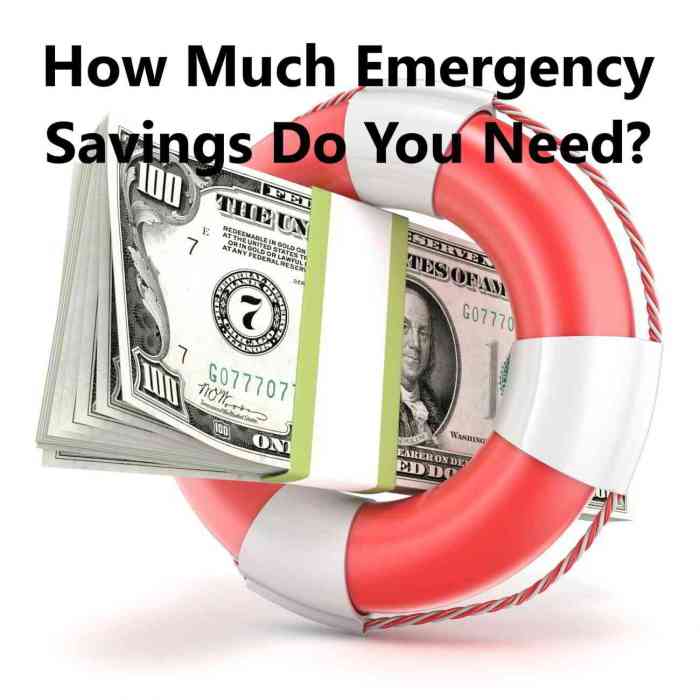Hey guys, let’s dive into the world of emergency preparedness savings and how it can be a game-changer in uncertain times. From setting up a safety net to navigating different savings options, get ready to level up your financial planning game!
Now, let’s break down the nitty-gritty details of how to secure your finances for those unexpected curveballs life throws at you.
Importance of Emergency Preparedness Savings
In a world full of unexpected twists and turns, having emergency preparedness savings is like having a superhero cape in your financial arsenal. It’s not just about setting aside some cash for a rainy day; it’s about being ready to face any storm that comes your way.
Financial Safety Net for Unexpected Situations
When life throws you a curveball, like a sudden job loss, medical emergency, or natural disaster, having emergency savings can be a game-changer. Instead of scrambling to figure out how to cover unexpected expenses, you can breathe a little easier knowing you have a financial safety net to fall back on.
Peace of Mind and Security
Picture this: you wake up in the middle of the night to the sound of a leaking roof or a broken-down car. Instead of panicking about how you’ll afford the repairs, you can sleep soundly knowing that your emergency preparedness savings have your back. It’s not just about the money; it’s about the peace of mind and security that comes with being financially prepared for whatever life throws your way.
How to Start Building Emergency Preparedness Savings

To begin building your emergency preparedness savings, it’s important to create a budget and set achievable goals for saving money. By having a plan in place, you can effectively save for unexpected expenses that may arise in the future.
Creating a Budget for Emergency Savings
- Start by calculating your monthly income and expenses to determine how much you can realistically save each month.
- Allocate a specific percentage of your income towards emergency savings, such as 10-20%, to ensure consistent contributions.
- Track your spending habits and identify areas where you can cut back to increase your savings potential.
Setting Achievable Savings Goals
- Establish short-term and long-term savings goals that are specific, measurable, and realistic.
- Consider creating an emergency fund that covers at least 3-6 months of living expenses to provide a financial safety net.
- Break down your savings goals into smaller milestones to stay motivated and track your progress over time.
Effective Money-Saving Strategies
- Automate your savings by setting up automatic transfers from your checking account to your emergency fund to ensure consistent contributions.
- Cut back on non-essential expenses, such as dining out or subscription services, to free up more money for savings.
- Look for ways to increase your income, such as taking on a part-time job or selling items you no longer need, to boost your savings potential.
Types of Accounts for Emergency Preparedness Savings
When it comes to building your emergency savings, choosing the right type of account is crucial. Let’s explore the various options available and how they can help you prepare for unexpected expenses.
Savings Accounts
A traditional savings account is a common choice for storing emergency funds. These accounts are easily accessible and offer low to no minimum balance requirements. While they may not offer the highest interest rates, they provide a safe and secure place to keep your money for emergencies.
Money Market Accounts
Money market accounts are similar to savings accounts but typically offer higher interest rates. These accounts may require a higher minimum balance and have limitations on the number of withdrawals you can make each month. Money market accounts are a good option for those looking to earn a bit more on their emergency savings while still maintaining liquidity.
High-Yield Savings Accounts
High-yield savings accounts are a popular choice for growing emergency funds. These accounts offer significantly higher interest rates compared to traditional savings accounts, allowing your money to work harder for you. While they may have higher minimum balance requirements, the potential for greater returns makes them attractive for those looking to boost their emergency savings over time.
Planning for Specific Emergency Situations
When it comes to emergency preparedness savings, it’s crucial to tailor your approach based on the specific types of emergencies you may face. Whether it’s a natural disaster like a hurricane or earthquake, or unexpected events like medical emergencies or sudden job loss, having a plan in place can make all the difference.
Tailoring Savings for Natural Disasters
When saving for natural disasters, consider the potential risks in your area. For hurricanes, you may need to budget for evacuation costs, temporary housing, and supplies. For earthquakes, focus on securing your home and having emergency funds for repairs.
Saving for Medical Emergencies or Job Loss
For medical emergencies, having a separate fund for health-related expenses can provide peace of mind. Similarly, setting aside money for sudden job loss can help cover essential bills until you find a new source of income.
Importance of Separate Funds for Various Emergencies
Having separate funds for different types of emergencies ensures that you’re prepared for any situation that may arise. By allocating savings specifically for each scenario, you can avoid depleting your overall emergency fund and stay financially secure in times of crisis.